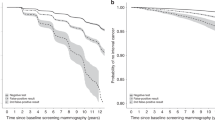Abstract
The results of the Swedish two-county study are analysed with respect to tumour size, nodal status and malignancy grade, and the relationship of these prognostic factors to screening and to survival. It is shown that these factors can account for much of the differences in survival between incidence screen detected, interval and control group cancers but to a lesser extent for cancers detected at the prevalence screen where length bias is greatest. Furthermore, examination of the relationships among the prognostic factors and mode of detection indicates that malignancy grade, as a measure of inherent malignant capacity, evolves as a tumour grows. The proportion of cancers with poor malignancy grade is several fold lower for cancers of diameter less than 15 cm than for cancers greater than 30 cm, independent of the length bias of screening. The implications of these findings for screening frequency are briefly discussed.
Similar content being viewed by others
Author information
Authors and Affiliations
Rights and permissions
About this article
Cite this article
Duffy, S., Tabar, L., Fagerberg, G. et al. Breast screening, prognostic factors and survival – results from the Swedish two county study. Br J Cancer 64, 1133–1138 (1991). https://doi.org/10.1038/bjc.1991.477
Issue Date:
DOI: https://doi.org/10.1038/bjc.1991.477
- Springer Nature Limited
This article is cited by
-
Mammography service screening and breast cancer mortality in New Zealand: a National Cohort Study 1999–2011
British Journal of Cancer (2017)
-
Breast cancer screening: evidence of benefit depends on the method used
BMC Medicine (2012)
-
Clinical significance of preoperative serum interleukin-6 and C-reactive protein level in breast cancer patients
World Journal of Surgical Oncology (2011)
-
The use of mammographic tumour feature significantly improves outcome prediction of breast cancers smaller than 15 mm: a reproducibility study from two comprehensive breast centres
memo - Magazine of European Medical Oncology (2011)
-
Population estimates of survival in women with screen-detected and symptomatic breast cancer taking account of lead time and length bias
Breast Cancer Research and Treatment (2009)




